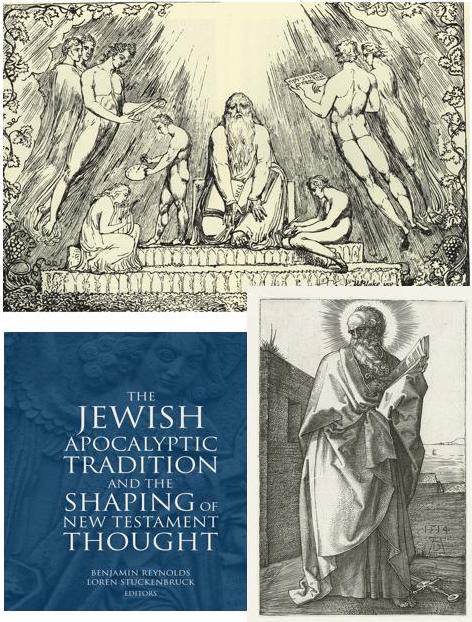| Warning: If you are looking for snazzy gotcha type parallels that demonstrate a genetic relationship between the letters of Paul and Enoch you will be disappointed. This post is not about direct imitation or identification of “a source” for Paul’s letter. The first page addresses form parallels; to see the content and ideas click “read more” to see the remainder. |
Professor James M. Scott compares two letters, one by Enoch and the other by Paul, and identifies a few points in common that help us understand a little more clearly the thought-world of both figures. Of course our real interest is in understanding Paul since we tend to see him as having more relevance to our Christian heritage than the evidently mythical Enoch.
Scott’s essay, “A Comparison of Paul’s Letter to the Galatians with the Epistle of Enoch” is a chapter in The Jewish Apocalyptic Tradition and the Shaping of New Testament Thought (2017, edited by Benjamin E. Reynolds and Loren T. Stuckenbruck). The central argument is that both Paul’s letter to the Galatians and the epistle of Enoch (1 Enoch 92-105) share the same apocalyptic motifs in a common letter format, and that it follows that Galatians belongs to the “apocalyptic tradition” as much as does the letter of Enoch. My interest is in the shared motifs per se, and what they indicate about Paul’s intellectual world.
1 Enoch is generally thought to be made up of five texts that have been stitched together, and one of these initially discrete texts consists of chapters 92 to 105, dated around 170 BCE. If you have sufficient time, patience and interest to read those chapters and have just a vague recollection of Paul’s letter to the Galatians you will wonder how on earth anyone could see the slightest resemblance between the two. Enoch’s letter is full of Old Testament style pronouncements of prophetic woes and doom on sinners while Paul’s letter is about struggles with Judaizers coming along to his converts in Galatia and undermining the pristine faith by telling them they had to be circumcised and follow a few other Jewish observances, too. But a glance at James Scott’s publishing history shows he has spent a lot of time studying all of this sort of literature so let’s continue in faith.
First, look at some “technical” similarities to see that, despite major differences, we are comparing a works of the same genre, a letter form. (The text follows Scott’s chapter closely, though of course the table format is mine.)
| Genre | ||
| Self conscious reference to his own writing as a letter | Galatians 6:11 See what large letters I make when I am writing in my own hand! | 1 Enoch 93:2 these things I say to you and I make known to you, my sons, I myself, Enoch.
1 Enoch 100:6 And the wise among men will see the truth, and the sons of the earth will contemplate these words of this epistle |
| Author | ||
| The superscription of both letters names the author of the letter, and then, adds an impressive description of the author: Paul is an “apostle” sent by God; Enoch is a “scribe” who writes “righteousness and truth”.
Both Paul and Enoch present themselves as authors who communicate God’s will. |
Galatians 1:1 Paul …. an apostle—[sent] not from men nor by man but by Jesus Christ and God the Father, who raised him from the dead ” This further description of who Paul is establishes from the outset the divine origin and agency of his apostolic commission, and thus, underscores his special authority. | 1 Enoch 92:1 Written by Enoch the scribe (this complete sign of wisdom) (who is) praised by all people and a leader of the whole earth. |
| Addressees | ||
| Both Galatians and the Epistle of Enoch are circular letters meant to be passed along to multiple readers in more than one location over the course of time. Enoch’s letter purports to be written in the seventh generation after Adam to be read by Jews and gentiles in the last days. | Galatians 1:2 to the churches of Galatia
|
1 Enoch 92:1 to all my sons who dwell on the earth, and to the last generations who will observe truth and peace.
|
| Both Galatians and the Epistle of Enoch address their respective readers throughout in the second person plural. | Galatians 4:19 My dear children | 1 Enoch 92-105 Enoch refers to his addressees as “my children“ |
| Salutation | ||
| In Galatians, the salutation is clearly identifiable.
The situation in the Epistle of Enoch is more complicated. The typical salutation or greeting is missing in 1 Enoch 92:1. Nevertheless, as Nickelsburg suggests, “it may be hinted at in the word ‘peace'” which comes at the end of the adscription in the same verse. |
Galatians 1:3 Grace to you and peace from God our Father and the Lord Jesus Christ
|
1 Enoch 92:1 to all my sons who dwell on the earth, and to the last generations who will observe truth and peace.
Nickelsburg also takes the final reference to “peace” in the Epistle (“And you will have peace,” 105:2) as “an epistolary conclusion.” |
| “Peace” is referenced at the beginning and ending both letters | Galatians 1:3; 6:16 | 1 Enoch 92:1; 105:2 |
| Very last word of both letters is “Amen” | Galatians 6:18 | 1 Enoch 105:2 |
Okay, that’s done with the “formalities”. We may say that technically we are comparing apples and apples. James Scott’s next section is more interesting for an insight into how much we read in Paul’s letter was part of the wider thought-world of the day and not “just Paul”. Scott turns to their common “apocalyptic elements”. Continue reading “Meet Paul and Enoch; both come from the same place”

